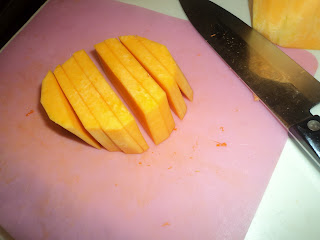Here's my way to cut Butternut Squash - I'm not very strong so I tend to look for the easiest way to do things. Necessity is the mother of invention, right?
Note: I often just pop the winter squashes, all of which are tough to cut and peel, into the oven, steamer, or dry crockpot, WHOLE, until tender. Then cutting and peeling become very easy (after sufficient cooling). But this time I wanted to make Fries so I wanted to cut the raw flesh.
First, lay the squash down on its side. Cut about 1/2 inch from the stem end, rocking/rolling the squash back and forth with your supporting hand (left hand for many) as you hold the knife steadily with your skilled hand. This is easier than trying to hold the squash still and gesticulating with the knife, I promise.
Then, cut the cylindrical part of the squash into about 3 thick slices (logs) in the same manner, rocking and rolling the squash again to help the knife go through. For fries, I cut the logs to be as thick as the length that I wanted the fries to be. Leave the bulb-shaped end aside for now.
(My go-to, much faster way to cook B.S. is to slice this part into medallions about 3/4 inch thick, dot with ghee or butter, and bake until tender in a 375 F oven. I keep the bulb part for soups.)
Peeling: taking one log at a time, lay it on the larger flat side and cut off the peel using the same knife, going down against the cutting board. If you always lay whatever you're cutting on the largest, flattest side and direct the sharp edge of the knife toward the cutting board and not your fingers or palm, you'll never need a band-aid (or stitches).
Put the peels in a pot. There's a lot of good squash there, we'll make Velouté de Butternut Squash!
Cut the log into fries: First, slice it into 6 to 8 pieces, depending on the size of the squash and the thickness you want your fries to be. The important thing is not what size you choose, but getting all the slices as even as you can, because the too-thin fries will burn while the too-thick ones will just be mushy and not crisp.
Then, make little stack of two slices at and make the final cut through the two slices at a time:
In the photo, four stacks of 2 slices each are laid on the cutting board. "1" is the stack before cutting, "2" is the stack as it is being cut, and "3" is the stack after being cut. TMI? It took less time to do the cutting than it did to write this! But the result is a pretty even bunch of French Fries. Put them in another pot, in which you've dolloped some coconut oil (or whatever fat or oil you choose).
Now let's deal with the bulb: lay it on the cut side. It's nice and flat, so it won't roll around while you cut it, reducing the risk of injury. First, cut it in half.
Then, lay each half on the largest cut side, in line with the principle of reducing the risk of injury, and cut the flower end off, taking off about 1/2 inch. Add the peel to the others in the pot.
Then, cut each half of the bulb into wedges, lay each wedge on its side, and cut it in three. Put the middle piece in the pot with the fries, and the other 2 pieces in the pot with the peels.
Put the fries pot on a little heat, just enough to melt the coconut oil, and toss to coat them, then spread them out on a baking sheet.
Here's a photo of the pot - holding quite a lot of "peels" and the fries, on the baking sheet. In reality, I had to bake them in batches, because they need to be far apart from each other, or they won't get crisp.
Bake them in a hot oven (400 F) until golden-brown. Watch carefully, they burn quickly!
We didn't find a need to add salt, they were so delicious!
For the Velouté: add 4 cups chicken broth, cook until very tender, process in a blender until very smooth. Add a sprinkle of nutmeg and salt and pepper to taste. Serve with a dollop of yogurt.
The fries disappeared before I could get a photo!








Wow, love this info! Thanks
ReplyDelete3 Researches SHOW Why Coconut Oil Kills Fat.
ReplyDeleteThe meaning of this is that you literally get rid of fat by consuming coconut fat (including coconut milk, coconut cream and coconut oil).
These 3 studies from major medicinal journals are sure to turn the conventional nutrition world around!